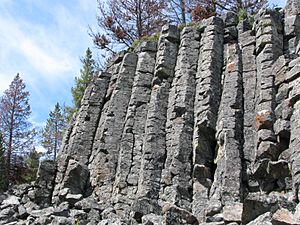Sheepeater Cliff facts for kids
The Sheepeater Cliffs are amazing rock formations found in Yellowstone National Park in the United States. These cliffs are made of a special type of rock called columnar basalt. Imagine giant columns, often with six sides, stacked together like huge pencils! These cliffs were formed by ancient lava flows and are a cool example of how powerful nature can be.
Contents
How Were These Cool Cliffs Formed?
The story of Sheepeater Cliffs began about 500,000 years ago. At that time, hot, melted rock (called lava) flowed out from deep inside the Earth. This happened during huge "basaltic floods" within the Yellowstone Caldera. A caldera is like a giant bowl-shaped dip in the ground, formed when a volcano erupts and then collapses. Yellowstone is famous for its supervolcano, and these lava flows were part of its fiery past.
From Lava to Rock Columns
When the hot lava cooled down, it didn't just become a flat sheet of rock. As it cooled, it shrank and cracked in a very special way. These cracks are called joints. They often form patterns that look like hexagons (six-sided shapes). This is why the cliffs look like they are made of many tall, six-sided pillars. It's like nature's own amazing sculpture!
Carved by the Gardner River
Over thousands of years, the Gardner River started flowing through this area. The river slowly but surely cut through the land, wearing away softer rocks and dirt. This process, called erosion, gradually exposed the hard basalt columns, creating the dramatic cliffs we see today. It's a great example of how rivers can shape the landscape.
Who Were the "Sheepeaters"?
The Sheepeater Cliffs get their name from a group of Native Americans called the Tukudeka. They were a band of the Eastern Shoshone people. The word "Tukudeka" means "sheep eaters." This name came from their main food source: the bighorn sheep that lived in the mountains of Yellowstone.
Living in Yellowstone
The Tukudeka people were very skilled at living off the land. They hunted bighorn sheep and other animals, gathered plants, and knew the Yellowstone area incredibly well. They used the natural resources around them to survive and thrive for many, many years before explorers from other parts of the world arrived. The cliffs are a reminder of their history and connection to this land.
Visiting Sheepeater Cliffs Today
Many parts of the Sheepeater Cliffs are in a steep canyon cut by the Gardner River, near Bunsen Peak. These areas can be hard to reach. However, some parts of the cliffs are much easier to see! You can find them right off the Grand Loop Road, which is a main road that goes through Yellowstone National Park. This makes it simple for visitors to stop and admire these unique rock formations from their car or a short walk. It's a popular spot for people to see a textbook example of columnar basalt.


